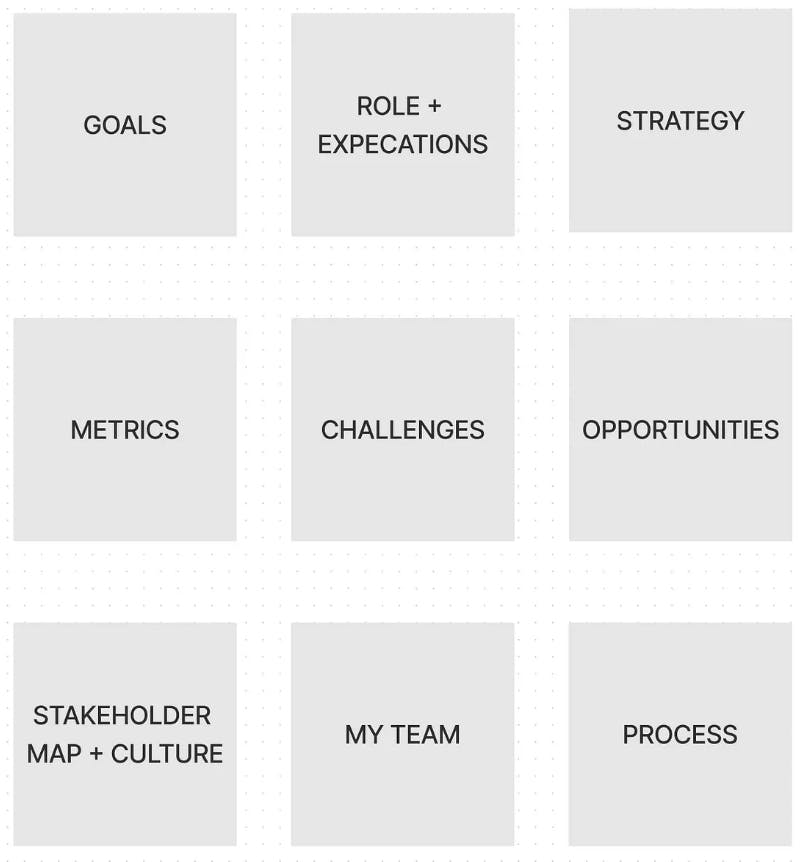Hi 👋, I’m Muj! I’ve recently joined the FT to embark on a new journey of improving the world of high quality news. It’s been a while since I’ve moved jobs, so remembering how to start a new job, in the new era of working from home, can be exciting and scary.

✍️ Why read this article?… This is a structure I’ve created to manage the information overload that can be the first 3 months of any job — not just as a product leader.
So here’s my approach on how to start your first 3 months as a Group Product Manager in 3 steps:
- Setting yourself up for success 🚀
- Start capturing! ✍️
- Validating your understanding 🧠
Setting Yourself Up For Success
🤝 Work with your manager to set up Intros
Being set up to meet with people you will work very closely at your new company is extremely important. The weight carried when your manager sets up a meeting with people they already have a close working relationship with is far better than an invite coming from a random person who’s just started at a company. This helps to start forging relationships, understand areas of the business and ultimately sets you up for success in your new job.
🥅 Draw out your 3 month goals
Set goals. Everyones goals for when starting at a new company will be different depending on the time you have to get started and the business needs.
The 4 key goals I had for my first 3 months revolved around gaining an understanding of the following:
- Vision and Strategy — Understand the why I am here and what I can impact by being here. E.g. Goal = draw out the strategy and review it with peers to ensure you understand it
- People — Who is everyone?! E.g. Goal = Meet all key people that can help me and my team drive towards the outcome we want to achieve
- Processes — How does the company work? Whats the culture like? E.g. Goal = Map out existing way of building products in the team and share it with the team to validate your understanding
- Opportunities — What are the opportunities? Short and Long Term? E.g. Goal = Define the quick wins VS the bigger challenges you want to solve by the end of month 3.
🗒 Create a Physical / Digital Whiteboard to Capture Stuff
This can be in the form of a Google Sheet, Google Doc/Word doc, a Miro board or a Figma Figjam, or even a big piece of paper that you always have with you (whatever works for you)! But just make sure you can easily add to it whenever and wherever 😊.
Start Capturing
✏️ Add Insights, Notes and Screenshots
I’ve created the ‘New PM Impact Grid’ (needs a better name! Any ideas, leave a comment ) to capture the following:

Throughout the first 3 months, I had a number of meetings. It allowed me to start capturing information within each of the boxes. The way I structured the information was by capturing:
- Information I heard that may help me carve out opportunities
- Screenshots / links to more information e.g. presentations shared
- Hearing out for existing issues
- Previous experiment results / numbers that may come in handy
- Capturing how things work through diagramming processes
- Existing challenges and opportunities
- Actions — captured by red post its to bring attention to it!
Goals
It’s important to capture your goals in the first 3 months of a job because it helps to establish clear expectations and objectives for your role within the company. Setting goals during this initial period allows you to focus your efforts on what is most important and to align them with the company’s overall mission and strategy.
Role + Expectations
Through speaking to people across the company, people may have different expectations of you. It’s important to understand what expectations people have across the business for the role you have filled and work on managing these expectations for their genuine needs, but also any misconceptions of how they expect you to have impact. This helps you to build trust and credibility.
Strategy
Understanding the company strategy in the first 3 months of a job is super important to understand 3 key things:
- Why your role exists: It helps you understand how your role fits within the broader context of the organisation. By knowing the company’s overall goals and objectives, you can better understand how your daily tasks and responsibilities contribute to the company’s success.
- How to set personal/team goals aganist company goals: It allows you to align your own goals and objectives with those of the company. When you understand the company strategy, you can set goals that are directly aligned with it, which helps to demonstrate your value to the organisation and also to increase your chances of achieving them.
- Driving decisions forward: It enables you to make informed decisions. By understanding the company’s strategy, you can make decisions that are in line with the company’s overall direction.
Metrics
By understanding the metrics that the company is tracking, you can gain insight into the areas of the business that are most important to the leadership team and the areas where they are focusing their attention.
Challenges
From a product leader’s perspective, capturing challenges of the customer, market and the business in the first few months of a job is one of the most important thing they can do because it allows for:
- Improved product outcomes: Understanding the challenges faced by team members and customers of the product can lead to improved product outcomes by ensuring we have necessary people and tools in place to be successful to meet customer needs.
- Better alignment: Capturing challenges can help product leaders to better align their team members with the company’s goals and objectives.
- Increased efficiency: By understanding and addressing challenges that teams and customers face early on, product leaders can increase the efficiency and focus of their teams by targeting the right problems earlier.
- Enhanced collaboration: Addressing challenges can improve collaboration among team members and lead to more effective teamwork.
Opportunities
Now the exciting part. You’ll find opportunities through all the conversations you have with peers across the company/industry. You’ll have to continuously capture them. But by the end of the 3 months, start categorising these issues into areas of issues, start to prioritise the short term low hanging fruit and the long term initiatives you’d like to take forward/investigate further.
Stakeholder Map
A stakeholder map allows you to identify all of the stakeholders that are involved around your area of responsibility, including internal stakeholders, such as employees and managers, and external stakeholders, such as customers, suppliers, and partners. This helps to visually understand the structure of the org, and understand the layers of support you have.
Also — start capturing what the culture is. Every organisation has their DNA and the ‘vibe’ they have created. Key questions to ask here are: What to watch out for? What culture exists here? Is it product led, tech led, sales led, exec led, hippo led? These questions allow you to navigate easier throughout the organisation.
Processes / Ways of Working
It helps to map out the way a company handles process and communications. It can help you to understand how decisions are made and how you can be most effective in your role. Key things to keep in mind:
- Product lifecycle process
- Existing processes within your individual teams
- Processes that require cross functional working outside product and tech departments
- How people across the company get updates
My Team
What you’re doing in the first 3 months is working with the team you manage to understand their responsibilities and see where you can help them, and trying to understand where you can help the team member in the future. But also, everyone has different background, likes, dislikes, is a morning person or is a night owl, so truly forging genuine professional relationships is extremely important to bring people with you on the journey to solving the problem space you’ll have the responsibility for.
Validating Your Understanding
👀 Sense Checking Ideas
It’s all good capturing issues and ideas, but it’s even better to sense check these ideas with people across the business + your manager to ensure you validate if it’s the right thing to focus your teams time and efforts on.
📣 Present your insights
Be prepared to share your insights with your team and senior leaders after your first 3 months. I’ve been there, at a company for a few years, and it’s always refreshing to be questioned and have a fresh set of eyes showing where we as a team/company can improve. However… please do this in a caring way not to offend. As a lot of people before you have done A LOT of great work before you joined the company.
Conclusion
The first 3 months have been a huge learning curve, and it’s more about understanding VS doing. So take the time, if you are a product manager/product leader, carve out a great understanding of what’s been mentioned above. This will help set you up for success when it comes to the “doing” and driving IMPACT 🎯.